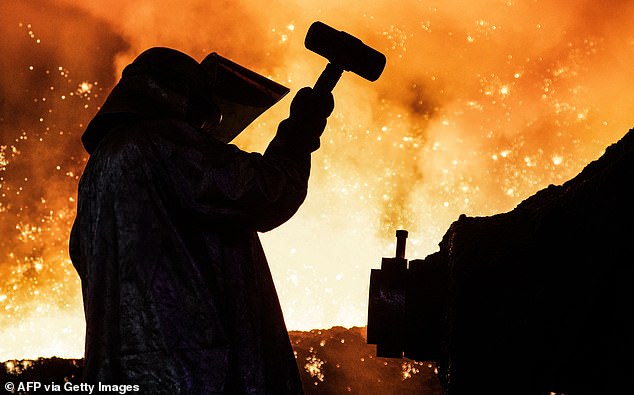Britain’s steel industry has been in sharp decline for decades. Domestic crude steel production fell last year to only 4m tonnes, the lowest total since the Great Depression of the 1930s.
And output is forecast to drop again this year, and for the next few years, until Tata’s electric arc furnaces come on stream at Port Talbot in 2028.
Yet even at such depressed levels, what’s left of the industry is of great strategic value. Home-made steel is used by the defence industry for rails, cars, housing, bridges, offshore wind turbines and cutting-edge Small Modular Reactors.
So, pretty critical to all the most vital parts of the country’s fabric as well as for national security.
More pertinently, steel-making also remains a big employer in some of the UK’s poorest communities, supporting 36,800 jobs and another 46,000 in the supply chain.
Which makes it all the more devastating that the industry – already suffering from global overcapacity because countries such as China and India heavily subsidise their industries – is once again under the hammer.

Challenges: UK steel output is forecast to drop again this year, and for the next few years, until Tata’s new electric arc furnaces come on stream at Port Talbot in 2028
What’s more, this blow could prove existential. Ironically, the latest threat comes from the UK’s biggest steel trading partner, the European Union: nearly 80 per cent of our steel exports – or 1.9m tonnes – went to EU countries last year.
But now the European Commission proposes tariffs of 50 per cent on steel imports worldwide above the quotas set over a decade ago.
This raises the likelihood that the UK could be flooded with even more cheaper imports, which would destroy the last of the still-standing steel companies.
Some 70 per cent of all finished steel products used in the UK are imported from overseas. As one industrialist put it: ‘This risks being Trump on steroids.’
Yet it is in the EU’s interests to come to some sort of deal with the UK as we are also the bloc’s biggest export market: this is not a zero sum game.
Last year, nearly two thirds of all UK finished steel imports came from the EU. Both trading partners have much to lose.
What, then, can be done to save the industry? UK Steel’s Gareth Stace urges the Government to pull two levers immediately.
First, use its preferential leverage with the EU to negotiate specific quotas with the UK. Second, for the Government to tighten imports quotas, probably by about half.
To date, Labour has woken up to the crisis. It has taken control of Chinese-owned British Steel and is supporting Tata with £500million of subsidies.
Now it needs to speed up its long-term steel strategy due later this autumn with cast-iron guarantees, particularly on import limits.
For the situation can only worsen. The OECD believes that worldwide steel overcapacity was 600m tonnes last year – and that in two years time that will have jumped to 721m tonnes.
That’s not an efficient marketplace. Half the world is subsidising its industry and the other half is imposing tariffs. Something has to give.
Roll with the punches
Another market that needs shaking up is NHS drug pricing. Over the last few weeks pharma bosses have been rolling with the punches, threatening to leave Britain because of our ‘appalling’ ancient regime for drug pricing, last updated in 1999, and which limits the amount spent per patient per year on drugs at £20,000.
Merck has gone. GSK’s Emma Walmsley warns that pricing makes the UK uncompetitive while AstraZeneca put on hold new investment at its Cambridge global research HQ.
Now chairman Shaun Grady has gone further, warning to halt all UK investment unless the regime changes. He also warns patients are being denied life-saving treatments.
This is plainly bad for patients, but also the UK’s life science industries, which is meant to be one of our most thriving.
Is this a case of pharma talking its own book? It’s not as simple as that. Drug pricing is complex – and a centuries old problem. There are two issues to be addressed.
The Quality Adjusted Life Years formula needs updating and the NHS should indeed spend more on medicines as a proportion of its budget – many of today’s drugs are preventative rather than therapeutic which makes them more cost-effective.
Wes Streeting, who walked out of the last industry meeting, should get back to the table.
DIY INVESTING PLATFORMS

AJ Bell

AJ Bell
Easy investing and ready-made portfolios

Hargreaves Lansdown

Hargreaves Lansdown
Free fund dealing and investment ideas

interactive investor

interactive investor
Flat-fee investing from £4.99 per month

InvestEngine

InvestEngine
Account and trading fee-free ETF investing
![]()
Trading 212
![]()
Trading 212
Free share dealing and no account fee
Affiliate links: If you take out a product This is Money may earn a commission. These deals are chosen by our editorial team, as we think they are worth highlighting. This does not affect our editorial independence.
Compare the best investing account for you